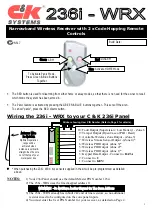
Spektrum AR7100
11
Spektrum AR7100
12
Failsafe Instructions
Standard Range Testing
Advanced Range Testing Using a Flight Log
The AR7100/AR7100R feature two types of fail-safe: SmartSafe
™
and
Preset Failsafe.
SmartSafe
This type of failsafe is recommended for most types of helicopters.
When the transmitter and receiver are turned on the receiver connects
to the transmitter and normal control of all channels occurs. If loss
of signal occurs, SmartSafe drives the throttle servo only to its preset
fail-safe position (low throttle) that was set during binding. All other
channels hold their last position. When the signal is regained, the
system immediately (less than 4 ms) regains control.
Preset Failsafe
When the transmitter and receiver are turned on and after the receiver
connects to the transmitter and normal control of all channels occurs,
if loss of signal occurs preset failsafe drives all servos to their preset
fail-safe positions. Some pilots prefer this method but normally
SmartSafe is recommended for helicopters. When the signal is
regained, the system immediately (less than 4 ms) regains control.
Programming SmartSafe
During the binding process the bind plug is left in throughout the
process and is removed only after the receiver connects to the
transmitter. After the connection is made, confirmed by operating
the servos, the bind plug can be removed. The receiver is now
programmed for SmartSafe.
Programming Preset Failsafe
During the binding process the bind plug is inserted in the bind
port, and then the receiver is powered up. The LEDs in each receiver
should blink, indicating that the receiver is in bind mode. Now before
binding the receiver to the transmitter and with the receiver in bind
mode, remove the bind plug. The LEDs will continue to blink. With
the control sticks and switches in the desired failsafe positions, bind
the transmitter to the receiver by putting the transmitter/module into
bind mode. The system should connect in less than 15 seconds. The
receiver is now programmed for preset failsafe.
Note: Fail-safe positions are stored via the stick and switch positions
on the transmitter during binding.
Before each flying session, and especially with a new model, it’s
important to perform a range check. All Spektrum aircraft transmitters
incorporate a range testing system which reduces the output power,
allowing a range check.
Range Testing
1. With the model resting on the ground, stand 30 paces (approx. 90
feet) away from the model.
2. Face the model with the transmitter in your normal flying position
and put your transmitter into range test mode. This causes reduced
power output from the transmitter.
3. You should have total control of the model while in range check
mode at 30 paces (90 feet).
4. If control issues exist, call the Horizon Product Support
department at 1-877-504-0233 for further assistance.
The following advanced range check will confirm that internal and
remote receivers are operating optimally and that the installation
(position of the receivers) is optimized for the specific aircraft. This
Advanced Range Check allows the RF performance of each receiver to
be evaluated and to optimize the locations of each individual remote
receiver.
Advanced Range Testing
1 Plug a Flight Log (SPM9540 - optional) into the data port in the
AR7100 and turn on the system (Tx and Rx).
2. Advance the Flight Log until F- frame losses are displayed by
pressing the button on the Flight Log.
3. Have a helper hold your helicopter while he observes the Flight
Log data.
4. Standing 30 paces away from the helicopter, face the model
with the transmitter in your normal flying position and put your
transmitter into range test mode. This causes reduced power
output from the transmitter.
5. Have your helper position the model in various orientations (nose
up, nose down, nose toward the Tx, nose away from the Tx, etc.)
while your helper watches the Flight Log noting any correlation
between the aircraft’s orientation and frame losses. Do this for 1
minute. The timer on the transmitter can be used here.
Press and hold the bind button
30 paces (90 feet)
































